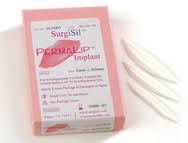Lip augmentation is one of the most popular minimally-invasive cosmetic procedures of the face. Done almost exclusively with injectable fillers, it produces instantaneous augmentation of the vermilion-cutaneous junction or the lip body proper. Of last year’s nearly 2 million injectable filler treatments performed in the U.S., a significant percent of them was for lip enhancement.
While there is a wide variety of injectable filler options, those fillers that are comprised of hyaluronic acid compositions work best in the supple and sensitive lip tissues. The immediate and usually satisfying results of injectable lip augmentation is why its drawbacks are tolerated. Lip injections have to be repeated for maintenance at a frequency based on the absorption of the material. With most hyaluron-based fillers, that can be expected to be anywhere from 3 to 9 months. In addition, there is some level of discomfort with injections which makes each treatment session a tolerated but not a pleasant experience.
The alternative to lip augmentation by temporary-lasting injections is through the use of synthetic implants. There has been a history of a variety of synthetic materials used as lip implants since the mid-1990s, most of which have gone out of favor. The most common material has been that of PTFE or Gore-Tex. Initially used as a multi-strand implant, it developed an unacceptable level of complications such as stiffness, bunching, nodules and lip distortion with movements. Another PTFE material, known as Advanta which is a dual-porosity soft tube, had better clinical results but is now no longer commercially available. I had used it for over a decade and had very good clinical results with it with few negative experiences.

The surgical technique to place the PermaLip implant can be done in the office under local anesthesia. Through small incisions placed just inside the mouth corners, the implant is slide into place using a small instrument. One of the biggest problems to overcome in the placing of lip implants is even placement at the right level in the lip from one side to the other. The technique for placing PermaLip implants largely overcomes the problem of lip asymmetry. One will experience some lip swelling for a week or so and occasionally some lip bruising may occur.

The success of any lip implant is both material and technique-based. It is important to place the implant in an intramuscular position and not immediately subcutaneous or submucosal. It is also important to not stress the lip tissues by placing too big of an implant. While PermaLip has sizes up to 5mms, a small (3mm) or medium (4mm) size is best for most patients. The implant volume/tissue ratio is important. A moderate lip size increase that has long-term success is better than a large lip size result that develops complications.
Dr. Barry Eppley
Indianapolis, Indiana


